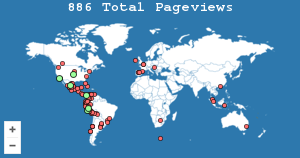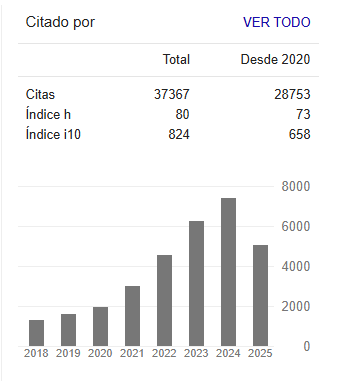Internal branding in a service company in Mexico
Abstract
The objective of this research is to analyze the internal branding processes of a knowledge services company in Mexico. This allows there to strengthen competitive advantages through their human capital. The foregoing elucidating whether training and motivation towards the brand positively influence its performance. The methodological strategy is quantitative through statistical tools and machine learning. Evidence shows that employees’ alignment with brand values shows a positive and significant impact on their motivation for the brand and its performance. The most significant factors within the commitment dimension are the training and leadership of the bosses.
References
Baumgarth, C., & Schmidt, M. (2010). How strong is the business-to-business brand in the workforce? An empirically-tested model of internal brand equity’in a business-to-business setting. Industrial Marketing Management, 39(8), 1250-1260.
Berry, L. L. (2000). Cultivating service brand equity. Journal of the Academy of Marketing Science, 28 (1), 128-137. https://doi.org/10.1177/0092070300281012
Buil, I., Martínez, E., & Matute, J. (2016). From internal brand management to organizational citizenship behaviours: Evidence from frontline employees in the hotel industry. Tourism Management, 57(1), 256-271.
Burmann, C., & Zeplin, S. (2005). Journal of Brand Management,. Building brand commitment: A behavioural approach to internal brand management., 12 (4), 279-300.
Burmann, C., Zeplin, S., & Riley, N. (2009). (2009). Key determinants of internal brand management success: An exploratory empirical analysis. Journal of Brand Management, 16(4), 264-284.
Chang, A., Chiang, H.-H., & Tzu-Shian, H. (2015). Investigating the dual-route effects of corporate branding on brand equity. Asia Pacific Management Review, 120-129.
De Chernatony, L. (1999). Brand Management through narrowing the gap between brand identity and brand reputation. Journal of Marketing Management, 15(2), 157-179.
Demovsek, D. (2008). Employee Retention Through Employee Engagement. International Journal of Business and Management Invention, 2319-8028.
Erkmen, E. (2018). Managing your brand for employees: understanding the role of organizational processes in cultivating employee brand equity. . ppp, 8(3), 52.
Esch FR., Rutenberg J., Strödter K. & Vallaster C. (2005). Verankerung der Markenidentität durch Behavioral Branding. In E. F. (eds), & W. Gabler Verlag (Ed.), Moderne Markenführung. Springer. https://doi.org/10.1007/978-3-8349-4541-9_40
Grace, D., & O’Cass, A. (2005). Service branding consumer verdicts on service brands. Journal of Retailing and Consumer Services, 12(2), 125-139. https://doi.org/10.1016/j.jretconser.200
Guardia, C. D. L.,Enrique, A. M. (2017). Revisión del concepto de internal branding: la transmisión de la promesa de marca a los clientes por parte de los empleados. Gráfica, 5(9).
Harris, F., y De Chernatony, L. (2001). Corporate branding and corporate brand performance. European Journal of Marketing, 35(3-4), 441-456. https://doi.org/10.1108/03090560110382101
Jacobs, R. (2003). Turn employees into brand ambassadors. ABA Bank Marketing, 35(3), 22-26.
Keller, K. L., & Swaminathan, V. (2019). Strategic brand management: building, measuring, and managing brand equity. Pearson Education.
Kimpakorn, N., & Tocquer, G. (2010). Service brand equity and employee brand commitment. Journal of Services Marketing, 24(5), 378-388. https://doi.org/10.1108/08876041011060486
King, C., & Grace, D. (2010). Building and measuring employee-based brand equity. European Journal of Marketing, 44(7-8), 938-971.: https://doi.org/10.1108/03090561011047472
King, C., & So, K. (2015). Enhancing hotel employees’ brand understanding and brandbuilding behavior in China. Journal of Hospitality & Tourism Research, 39(4).
King, C., Grace, D. & Funk, D. (2012). Employee brand equity: Scale development and validation. Journal of Brand Management, 19, 268–288. https://doi.org/10.1057/bm.2011.44
Krystallis, A., & Chrysochou, P. (2014). The effects of service brand dimensions on brand loyalty. Journal of Retailing and Consumer Services, 21(2), 139-147.
Martínez, G., De Cuyper, N., y De Witte, H. (2010). Review of the job insecurity literature: The case of Latin America. Avances en Psicología Latinoamericana, 28(2), 194-204.
Mitchell, T. R. (1982). Motivation: New directions for theory, research, and practice. Academy of Management Review, 7, 80–88. https://doi.org/10.5465/amr.1982.4285467
Morhart, F. M., Herzog, W., y Tomczak, T. (2009). Brand-Specific Leadership: Turning Employees into Brand Champions. Journal of Marketing, 73(5), 122-142. https://doi.org/10.1509/jmkg.73.5.122
Murillo, E. (2016). Internal Branding: Developing Brand Ambassadors. Dirección Estratégica.
Murillo, E. (2019). El branding interno como antecedente de la autoestima basada en la organización: Un estudio en una cadena de restaurantes. . Entreciencias: Diálogos en la sociedad del conocimiento, 7(21), 37-52. http://dx.doi.org/10.22201/enesl.2
Murillo, E. (2020). Branding interno en organizaciones de comercio minorista: un en una cadena de farmacias. Mercado y Negocios, 21(42), .
Murillo, E., & Terán-Bustamante, A. (2020). (2020). El branding interno en la economía colaborativa: un estudio exploratorio de Uber. Revista espacios, 41(22), 268-282.
Perrin, T. (2003). Working Today: Understanding What Drives Employee Engagement. . The 2003 Towers Perrin Talent Report.
Punjaisri, K., & Wilson, A. (2011). Internal branding process: key mechanisms, outcomes and moderating factors. European Journal of Marketing, 45(9-10), 1521-1537.
Punjaisri, K., Evanschitzky, H., & Wilson, A. . (2009). (2009). Internal branding: An enabler of employees’ brand-supporting behaviours. Journal of Service Management, 209-226.
Raeisi, S., Lingjie, M., & Suhaili, N. (2019). A Hierarchical Model of Mediation Effect of Motivation (MO) between Internal Marketing (IM) and Service Innovation (SI). Administrative Sciences, 9(4), 85.
Robinson, S. L. (1996). Trust and breach of the psychological contract. Administrative Science Quarterly, 41, 574-599.
Schultz, D. (2003). IMC: The next generation: Five steps for delivering value and measuring returns using marketing communication. McGraw Hill Professional.
Sirianni, N. J., Bitner, M. J., Brown, S. W., y Mandel, N. (2013). Branded service encounters Strategica-lly aligning employee behavior with the brand positioning. Journal of Marketing, 77(6), 108-123. https://doi.org/10.1509/jm.11.0485
Tamm, A.(2015). El Branding Interno y su impacto en tu Empresa. Auren México, (2). https://auren.com/mx/wp-content/uploads/2019/12/brandinginterno-atamm.pdf
Terglav, K., Ruzzier, M. K., & Kaše, R. (2016). (2016). Internal branding process: Exploring the role of mediators in top management’s leadership-commitment relationship. International Journal of Hospitality Management, 54(1), 1-11.
Varun K, Indu B and Ashish K. (2015). Internal Branding: A Review of Indian Hotel Industry. Advances In Management, 8(11).
Wirtz, J., & Lovelock, C. (2016). Services Marketing: People, technology. World Scientific Publishing Company.
Xiong, L., King, C., & Piehler, R. (2013). That’s not my job: Exploring the employee perspective in the development of brand ambassadors. International Journal of Hospitality Management., 35, 348-359.
Xiong, L., y King, C. (2015). Motivational drivers that fuel employees to champion the hospitality brand. International. Journal of Hospitality Management, 44, 58-69. doi:https:// doi.org/10.1016/j.ijhm.2014.10.009
Yaniv, E., y Farkas, F. (2005). The impact of person-organization fit on the corporate brand perception of employees and of customers. Journal of Change Management, 5(4), 447-461.
Zeithaml, V. A., Bitner, M. J., & Gremler, D. D. (2010). Services marketing strategy. Wiley International. Encyclopedia of Marketing, 1, 208-218.








.png)






























